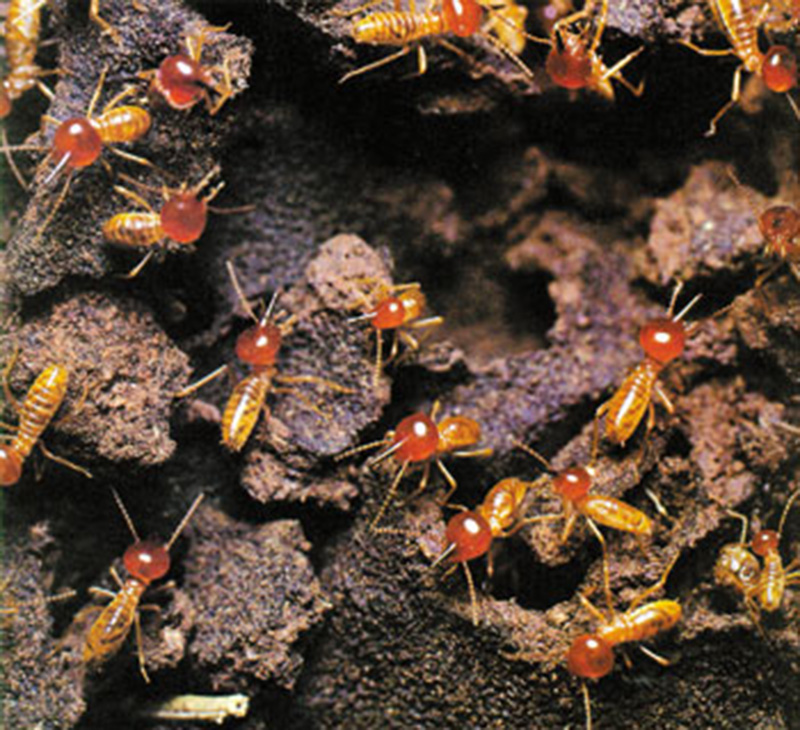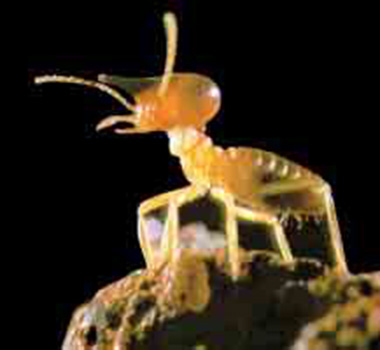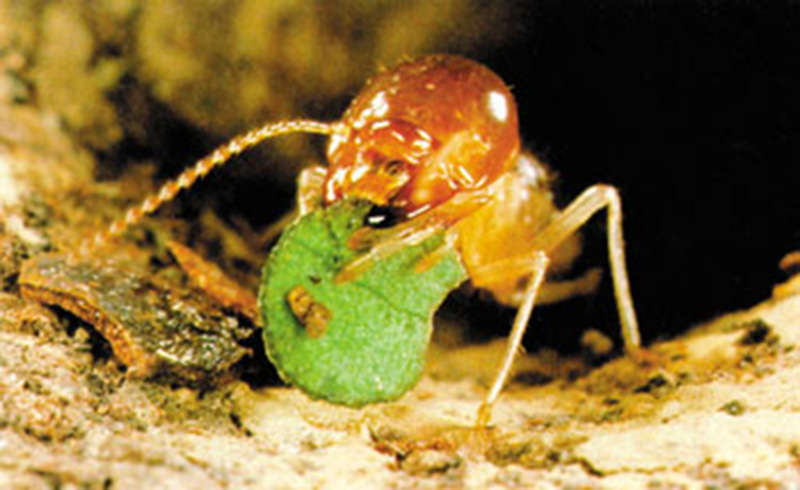Social life in a termite colony is flawless. The termites act together simultaneously as one body and cooperate in performing all functions of the community. And, if we consider that sometimes termites live with at least one million others, we can easily understand the importance of a system of communication that allows termites to provide a working area, come together and join forces against intruders and manage all the other needs of the colony in perfect harmony. This communication system is based on the exchange of chemical signals through smell or taste.
Now, let’s compare the functioning of a million-member termite community with that of a human community of the same size.
 |
| It takes a lot of effort for a group of 30 to 40 individuals to live together. Good organization is essential. However, countless termites have lived together for millions of years without trouble or confusion. |
Think of more than 1,000,000 human beings living and working together in one place. Imagine that they fulfill their cleaning, ventilation, temperature and nutritional requirements all by themselves.
Performing such functions with such a large number of individuals would certainly take a lot of time and labor. A well planned organization would be required to avoid confusion and breakdowns in the system. There would have to be a very good communication and labor-distribution systems.
It is extremely difficult for one million human beings to work together as one. Indeed, problems arise when only 30 or 40 people try to live together in a group. To establish order in such an organization would take at least a good amount of time.
Human beings are the only creatures in the world with intelligence. They have the powers of judgment and technological skill, and they can plan for the future. A termite is an insect 1 to 2 cm (0.3 to 0.7 of an inch)-long. This comparison is to show how important it is for termites to live together successfully in a colony. As you'll see in later pages, termites lack the intelligence that would allow them to build skyscrapers and install heating/cooling systems.
About 1 million termites, and sometimes more, manage to perform these feats with no problems, showing that they have a well-organized communal life and a very good system of communication. We may well be curious about a communication system that lets one million individuals work together as one. Termites are blind; how do they understand one another? How can they create a work area? How can they build magnificent towers without any confusion? Being blind, how can they recognize enemies? How can they fight together against one? The answers to these questions provide a key to a very important truth.
 |
| Every termite colony has its own chemical secretion. No termite without this secretion is admitted into the nest. Termites at the entrance to the nest are able to make the distinction, using antennas with scent-receptive cells. An insect such as the one pictured at right can recognize members of its own colony by making a quick chemical analysis. |
Termites’ established society depends on a system of mutual communication. But they have no trouble in exchanging information. All essential activities such as building, finding food, recognizing others belonging to the same nest, following tracks, physical development, sounding the alarm against intruders and defending the nest are determined—as with other insects—through chemical signals.
As with other insects, termites use chemical secretions called pheromones to communicate. Every colony has its own particular smell. For example, when the colony is invaded, the queen is informed when the workers smear secretions on the food they bring her. She in turn secretes an alarm secretion which orders soldiers to go to the site of the intrusion. In addition, when workers find a new source of food, they leave a secret chemical scent that other members of the nest can follow, leading them to find the new source of food.
As said before, the number of individuals in each caste and the proportion of workers to soldiers are also determined by means of chemical secretions. The queen determines whether the developing larvae will become soldiers, workers, or prospective kings or queens, according to the needs of the colony; and by means of secretions, she informs the workers as to which class the larvae belong.25
Besides communicating by chemical secretions, termites also have very sensitive antennae. A series of cells on their antennae can perceive scents, allowing termites to recognize one another and to perceive the smell of other insects not of their species.
Insects have a protective covering called the chitin-protein layer. This layer contains glands that exudes hydrocarbon molecules with a special scent that termites are able to perceive. This is how they can detect a foreign insect trying to enter the nest.
How does their scent-detection ability work? To answer this, we can compare termites with a scanner that’s able to read barcodes (the special price and destination codes on merchandise).
Just as the computers in a company’s security system can recognize the code inscribed on security cards, so termites can tell the difference between the scent of an ant and that of another termite. Termites’ antennas are so sensitive that they can detect by its scent whether another termite is a member of their colony. In addition, every termite species and even every nest within the same termite species has its own odor. The fact that termites can differentiate these scents makes them experts in the art of “smelling.” And their antennae serve as the most effective means of monitoring the security of the nest.
Scientists have investigated how blind termites can know when another insect tries to enter their nest and how they can recognize that other termites are not members of their colony. Chemical analyses (spectrometry and gas chromatography) of the scent that termites exude have definitely shown that different species of termites (e.g. Reticulitermes santonensis and Reticulitermes lucifugus grassei) exude different scents.26
Besides this, when researchers transferred the shell or carapace of a termite from one nest onto a termite from another nest, they found that every time the foreign termite carrying the scent of the first nest tried to enter the second one, it was expelled.
Such expertise in smelling is not an ability that termites could have acquired later in their development. Every termite must have been born with this system already in place, because blind termites couldn’t have survived without their antennae. Their ability to find directions and to defend themselves and the colony all depends on their antennae’s ability to recognize signals sent by the queen. This also shows that termites’ antennae were created at the same time as their secretion glands, together with all the other components that make up their systems.
Though termites’ security precautions are extremely effective, this does not prevent every intruder from entering the nest. In spite of all its security precautions, there is another species of ant that’s able to enter into the colony.
How they can do this is amazing: The Ponerine subfamily of ant exudes the scent not of an ant but of a termite! Thus it is able to penetrate the termites’ security system and wander freely throughout the nest. Being blind, the termites detect these ants’ scent and mistakenly think they are “members of the family.”
This very effective ability of ants to fool termites is an example of a flawless and impressive creation. This “ant success story” raises the especially interesting question of how the ants discovered the termites’ special scent. Can one creature possibly duplicate the chemical substances in the body of another? How did these ants know about the termites’ security system in the first place? And how do they know that they can wander freely among termites, once they secrete this scent? But above all, how did they gain the ability to produce in their own bodies chemical substances found in the bodies of termites?
There is only one answer to all these questions: Some Power has informed these ants about the termites’ security system. This Power knows how both ants and termites are made, because He has designed and created these ants’ physical systems. God is the incomparable Power that created both these creatures. He knows everything, and has total knowledge of all creation:
Everyone in the heavens and Earth belongs to Him. All are submissive to Him. It is He Who originated creation and then regenerates it. That is very easy for Him. His is the most exalted designation in the heavens and the Earth. He is the Almighty, the All-Wise. (Surat ar-Rum: 26-27)
 |
| Here we see a termite taking a leaf to its nest. It finds its way by following the scent it secreted earlier from glands in its thorax. |
Termites also communicate using sound. By striking the walls of the tunnels with their heads, worker and soldier termites produce vibrations throughout their nest that summon other termites. The other termites feel this reverberation with extremely sensitive feelers in their legs.
The termites know that they will produce a reverberation throughout the nest by striking the tunnel walls with their heads and that this message will be understood by the other termites. This method of communication resembles Morse code. Of course, someone must be trained in Morse code; no one can learn the code spontaneously by chance and make random sounds that others can understand. Both the sender and the receiver must know the code, or no matter how important the message, it can’t be understood.
Just as Morse code cannot be learned spontaneously, so termites cannot have discovered their communication code by chance. Termites must know this communication system from the moment they are hatched. So, to suppose that termites acquired this ability by themselves and by chance is unscientific and illogical.
Receptors are not formed on a creature’s body by chance. Chance cannot help signals emitted by one creature understood by another. In short, no creature acquires its traits by chance.
This communication system is taught to termites; or rather, it is inspired into them. In the Qur’an, God gives the example of a honeybee; He tells us that this creature moves by His revelation:
Your Lord revealed to the bees: “Build dwellings in the mountains and the trees, and also in the structures which men erect. Then eat from every kind of fruit and travel the paths of your Lord, which have been made easy for you to follow.” From inside them comes a drink of varying colors, containing healing for humanity. There is certainly a Sign in that for people who reflect. (Surat an-Nahl: 68-69)
Like the honeybee, every creature on earth moves by God’s revelation and is totally subject to Him.